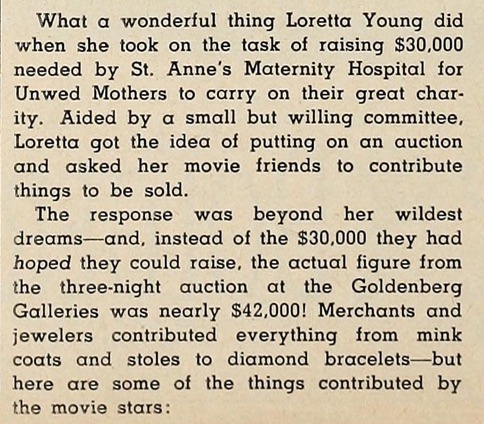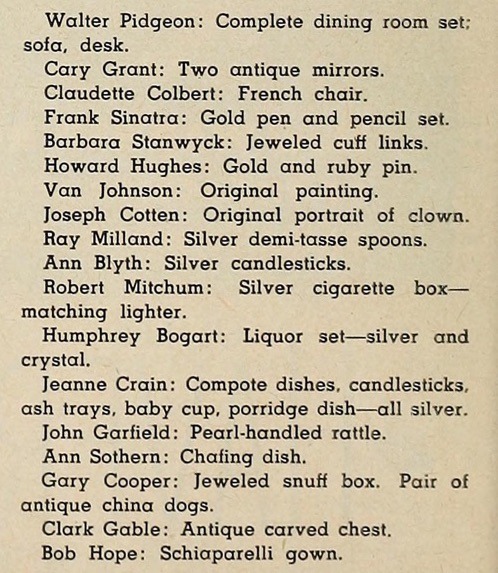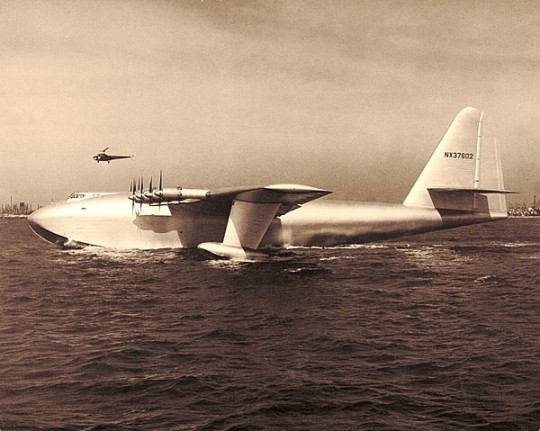#HOWARD HUGHES
Explore tagged Tumblr posts
Note
i need a list of your shortest facts to read off to friends in udder dead pan. most of the recent facts are too long to read off.
My shortest few factoids-
I've never written any short factoids.
I never tried to do one.
Short facts are hard.
Billionaire Howard Hughes once attempted to make a film of 20,000 Leagues Under the Sea and the production would become one of Hollywood’s greatest disasters, taking the lives of over 90 actors and crew, costing nearly half a billion dollars, destroying an entire island, and almost causing a 3rd world war. A party was held to mark the start of production at one of Hughes’ seaside homes and was sadly marred when a drunken Hughes began shooting into the air with his crossbow and killed an albatross, which fell into the punch bowl, offending several actors, who departed the production. This caused a massive production delay during which Hughes bought up over 50 warehouses (including the world’s largest building at the time) to hold the sets and specially built water tanks until casting was replenished. Two of these warehouses burned down (including the world’s largest building fire at the time), destroying the sets which then had to be rebuilt. By the time Hughes decided to cast unknown actors in the lead roles, ten more major set pieces had rotted away delaying the production further. Finally in October of 1948 the new sets and all actors were in place on the luxurious island of Bikini Atoll. The crew was to arrive at the shooting location on October 26th but was delayed by weather. This turned out to be a good thing as the United States conducted an unannounced nuclear test on October 27th, annihilating the island and the sets completely. The island is still toxic, and Howard Hughes, who owned the island, was compensated only $212 for his losses by the government. Undeterred, Hughes began again with fresh sets, and new actors as the previous group had long since departed by 1950. This time, production finally began and footage was shot. It was never developed however because despite the expenditure of $800,000 on pyrotechnics for the first scenes shot, nobody had thought to temperature-protect the film canisters, which were opened at the lab and found to have melted completely into what amounted to large plastic pucks. Hughes filmed the scene again, at the same cost, and then a third time when he was not satisfied with a background extra’s hair. This new footage too was lost when it was captured by rebellious 1950s teenagers who held it for ransom. They asked only $50 but Hughes refused to pay on principle. The actors and crew were even more upset than Hughes that their work had been for nothing and so began the “Leagues Riots” of 1951. What sets remained were once more burned down, this time in protest. Then the real problems began. By then, the Disney production was under way and Hughes spent millions more to spy on and sabotage the rival production. Several Disney employees fell victims to car bombs, others to arsenic poisoning, and one to auto-erotic asphyxiation, but Hughes was not considered responsible for that particular event. Walt Disney, of course, declared war. The “War Between The Sets” began in 1953 as Hughes forces were driven off by Disney’s hired guns, the Mouseketeers which in those days were a fully armed paramilitary force. This skirmish took seven lives, but it was only the beginning. Hughes used his government contracts to secure two bombers and arms weighing in excess of 500 tons, all of which were dropped on Disney owned installations. Disney’s retaliation was severe. Hughes hotels burned days after, there were so many fires that Vegas and LA were both lit as bright as daylight even at midnight from the blazes. Hughes responded with bombings and drone strikes, with “drone strikes” in 1953 referring to dropping bees on ones enemy. The conflict at one point threatened to spill over into Russia’s Southern American interests, leading the president to demand Hughes back down before turning the cold war into a nuclear conflict. By the time a truce was called, Disney’s film was in theaters and Hughes was ready to call it a loss.
Mice can't fart.
303 notes
·
View notes
Text

The Rocketeer (1991)
#1991#film#movie#The Rocketeer#Billy Campbell#Cliff Secord#Jennifer Connelly#Jenny Blake#Timothy Dalton#Neville Sinclair#Terry O'Quinn#Howard Hughes#Dave Stevens#Los Angeles#California#rocket pack
28 notes
·
View notes
Text

Howard Hughes in the cockpit of the 300,000 pound, wooden hull "Spruce Goose". It was the largest plane ever built, had a 320 ft wingspan. It was a huge boondoggle and it flew only once, with Hughes stubbornly piloting it to prove it was airworthy.

More here
175 notes
·
View notes
Text
Letters of Howard Hughes and Katherine Hepburn




(A collection of letters from 1937 to 1938)
22 notes
·
View notes
Text

Jean Harlow-Ben Lyon "Los ángeles del infierno" (Hell´s angels) 1930, de Howard Hughes.
20 notes
·
View notes
Text

“Legend has it that Howard Hughes stashed Faith Domergue in a Hollywood hideaway and almost forgot where he’d left her. True or not, he did keep her waiting around for years while he fashioned the ideal launching pad for her talents. But unlike Hughes’ greatest hype The Outlaw (1948) with Jane Russell, Faith’s premier effort Vendetta (1950) was the victim of its own massive publicity campaign. She ended up in Planet of the Prehistoric Women (1965) and worse. If Faith is remembered at all, it will be as another of Hughes’ Follies, his celluloid Spruce Goose.”
Author Penny Stallings’ casual dismissal of gorgeous starlet Faith Domergue’s Hollywood career in her 1978 book Flesh and Fantasy is pithy but also overly dismissive. If the destiny of Howard Hughes’ protégée (they met when she was 16) lay in in science fiction and horror b-movies (like It Came from Beneath the Sea (1955), The Atomic Man (1955) and Voyage to the Prehistoric Planet (1965)) rather than the A-list, it certainly wasn’t from lack of talent or beauty on her part. Domergue is absolutely spellbinding in the wonderful 1950 film noir Where Danger Lives opposite Robert Mitchum. And I’ve always yearned to see the Cult of the Cobra (1955), which isn’t streaming anywhere in the UK, damn it! I just recently watched Domergue’s second-last film So Evil, My Sister (1974) (aka Psycho Sisters. Tagline: “Death runs in the family”. She did one more after this: The House of Seven Corpses (1974)). Anyway, So Evil is a gloriously threadbare trashy no-budget exploitation flick in which Domergue (sporting impressive jet-black lacquered bouffant helmet hair) and Susan Strasberg play twisted sisters who constantly gaslight and double-cross each other. It’s a blast and it’s on YouTube! Coincidentally, Domergue (16 June 1924 – 4 April 1999) was born on this day 100 years ago.
#faith domergue#howard hughes#old showbiz#classic hollywood#old hollywood#lobotomy room#golden age hollywood#film noir#horror movies#science fiction#so evil my sister#psycho sisters#cult of the cobra#where danger lives#vintage sleaze#kitsch#starlet#hollywood scandal
35 notes
·
View notes
Text


Today in 1938, Howard Hughes set a new record by completing a 91-hour airplane flight around the world.
25 notes
·
View notes
Text

Howard Hughes, in top hat facing camera, and his crew of four men are greeted by a crowd as they arrive at Floyd Bennett Field, July 14, 1938. They set a new record of 3 days, 19 hours and 17 minutes on Hughes's around-the-world flight in a special Lockheed 14.
Photo: Associated Press
#vintage New York#1930s#Howard Hughes#early aviation#aviation record#Lockheed 14#July 14#14 July#crowd#vintage NYC#Floyd Bennett Field
22 notes
·
View notes
Text

Lockheed L-1049 Super Constellation N6909C. ➤➤ Constellation VIDEO: https://youtu.be/ZpLhtrRIIDA ➤➤HD IMAGE: https://dronescapes.video/LC
#lockheed#constellation#howard hughes#youtube#aircraft#airplane#aviation#dronescapes#documentary#aviation history
39 notes
·
View notes
Text
Excerpt from a 1972 interview with Joan Blondell done on the set of Banyon (1972-1973). Taken from Conversations with Classic Film Stars: interviews from Hollywood's golden era (2016) by James Bawden and Ron Miller.








#joan blondell#james bawden#ron miller#hollywood#old hollywood#classic hollywood#warner brothers#warner bros#studio system#1930s#1931#no SAG yet#night nurse#barbara stanwyck#big business girl#loretta young#the public enemy#william wellman#bill wellman#james cagney#jimmy cagney#jean harlow#howard hughes#ed woods#eddie woods#illicit#the depression
12 notes
·
View notes
Text

The Rocketeer (1991)
#1991#film#movie#aviation#The Rocketeer#Billy Campbell#Cliff Secord#Jennifer Connelly#Jenny Blake#Timothy Dalton#Neville Sinclair#Terry O'Quinn#Howard Hughes#Dave Stevens#Los Angeles#California#Zeppelin#rocket pack
36 notes
·
View notes
Text



Modern Screen Magazine, September 1949.
#1940s#modern screen magazine#loretta young#irene dunne#deborah kerr#ray milland#rosalind russell#walter pidgeon#cary grant#claudette colbert#frank sinatra#barbara stanwyck#howard hughes#van johnson#joseph cotten#ann blyth#robert mitchum#humphrey bogart#jeanne crain#gary cooper#clark gable#bob hope#ann sothern#john garfield#old hollywood#old movie stars#old magazines#old movies#classic hollywood
65 notes
·
View notes
Text
H-4 Hercules plane






October 29th, 1980, the Hercules plane made by Howard Hughes and the Hughes Aircraft Company emerged from Long Beach, California. First tested on November 2, 1947, it was designed to be an airlift flying boat.
17 notes
·
View notes
Text

Hughes H-4 Hercules
The Hughes H-4 Hercules (commonly known as the Spruce Goose; registration NX37602) is a prototype strategic airlift flying boat designed and built by the Hughes Aircraft Company. Intended as a transatlantic flight transport for use during World War II, it was not completed in time to be used in the war. The aircraft made only one brief flight, on November 2, 1947, and the project never advanced beyond the single example produced.
46 notes
·
View notes
Text
List of Films Turning 20 Years Old in 2024
The Alamo (the one with Dennis Quaid)
Alexander ((the Alexander the Great biopic directed by Oliver Stone and starring Colin Farrell)
Alien vs. Predator
Anchorman: The Legend of Ron Burgundy
The Aviator (the Howard Hughes biopic directed by Martin Scorsese and starring Leo DiCaprio)
Barbershop 2: Back in Business
Before Sunset
Blade: Trinity
The Bourne Supremacy
The Butterfly Effect
Catwoman
Cellular (an action-thriller starring Kim Basinger and Chris Evans)
The Chronicles of Riddick
Closer
Collateral
Dawn of the Dead (the remake directed by Zack Snyder and written by James Gunn)
The Day After Tomorrow
Dodgeball: A True Underdog Story
Downfall
Eternal Sunshine of the Spotless Mind
Fahrenheit 9/11 (the Michael Moore documentary about how the Bush administration handled the aftermath of September 11, as well as their handling of the Invasion of Iraq)
50 First Dates
Finding Neverland (a biopic about J. M. Barrie, the guy who wrote “Peter Pan”. Barrie was played by Johnny Depp)
Friday Night Lights
Garden State
Ghost in the Shell 2: Innocence
Harold & Kumar Go to White Castle
Harry Potter and the Prisoner of Azkaban
Hellboy
Hidalgo
Home on the Range (one of Disney's most often forgotten animated movies)
House of Flying Daggers
Howl's Moving Castle
I Heart Huckabees
I, Robot
The Incredibles
Kill Bill Volume 2
King Arthur (the one with Clive Owen)
The Ladykillers (the remake of the 1955 movie of the same name directed by the Coen Brothers)
Layer Cake (the first movie directed by Matthew Vaughn, who would go on to direct “Kick-Ass” and “Kingsman”)
The Life Aquatic With Steve Zissou
The Lion King 1 1/2
The Machinist (the movie where Christian Bale lost like 60 pounds)
The Manchurian Candidate (the remake of the movie of the same name starring Denzel Washington)
Mean Girls
Million Dollar Baby
Miracle
Napoleon Dynamite
National Treasure
The Notebook
Ocean's Twelve
The Passion of the Christ
The Phantom of the Opera
The Place Promised in Our Early Days (the first film directed by Makoto Shinkai)
The Polar Express
Primer ((the time travel movie where you sit in a box for 12 hours and be back in time 12 hours. I think.)
The Punisher (the Thomas Jane one)
Ray (the Ray Charles biopic)
Resident Evil: Apocalypse
Saw (the 1st one)
Scooby-Doo 2: Monster Unleashed
Seed of Chucky
Lemony Snicket's A Series of Unfortunate Events
Shaun of the Dead
Shrek 2
Sky Captain and the World of Tomorrow
Spanglish
Spider-Man 2
The Spongebob Squarepants Movie
Team America: World Police
The Terminal
13 Going on 30
Troy
Van Helsing
The Village
#dennis quaid#alexander the great#oliver stone#colin farrell#alien vs predator#will ferrell#howard hughes#martin scorsese#leonardo dicaprio#marvel blade#richard linklater#before trilogy#jason bourne#matt damon#catwoman#halle berry#kim basinger#chris evans#vin diesel#riddick#michael mann#tom cruise#dawn of the dead#zack snyder#james gunn#ben stiller#vince vaughn#jim carrey#adam sandler#jm barrie
26 notes
·
View notes
